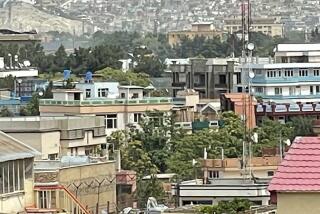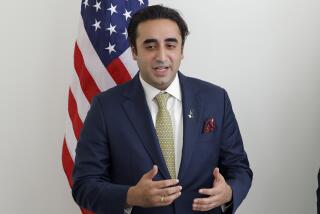Pakistan tribal region no simple target
Reporting from Rawalpindi, Pakistan â A couple of decades ago, Hamid Gul could trek into militant camps in North Waziristan like an old friend stopping by for dinner. Back then, he was Pakistanâs intelligence chief, and his hosts valued him as their benefactor in the struggle against Soviet troops in Afghanistan.
âI used to travel there frequently,â Gul says. âEverything was hunky-dory.â
The neighborhood has changed, and the friendships too.
Islamic militant camps still dot the regionâs rugged mountainsides and basins, but these days they shelter and train a caldron of disparate exremist groups with varying roots and an evolving network of allegiances. The regionâs hit list has also changed; North Waziristan militants now set their sights on the West and the rest of Pakistan.
The changing lineup of militant organizations in North Waziristan will make the task of uprooting militancy from the region and the rest of the tribal areas doubly hard, experts say. It will require a large, reliable corps of informants and operatives, and Pakistan has yet to replenish the ranks of Waziristan spies discovered and executed by militants.
âItâs turned into a cobweb there, and breaking it up will be very difficult,â said Imtiaz Gul, a security analyst and author of âThe Most Dangerous Place,â a new book about Pakistanâs tribal belt. âIt will take a lot of intelligence for the military to be able to penetrate these groups.... And they donât have it. They lost it over the past three years in both North and South Waziristan.â
Whatever the challenges, uprooting militants from North Waziristan is a job the U.S. wants Pakistan to undertake as quickly and decisively as possible.
The saga of Faisal Shahzad has fueled Washingtonâs drive for action in North Waziristan. The 30-year-old Pakistani American is suspected of training with Pakistani Taliban militants in the tribal belt along the Afghan border before attempting to trigger a car bomb in New Yorkâs Times Square on May 1.
Renewed pressure from Washington for an offensive in North Waziristan has put Pakistani officials in a dilemma: If they ignore U.S. demands, they risk souring relations with Washington at a time when the Obama administration is gearing up to begin channeling to Pakistan money from a five-year, $7.5-billion economic aid package approved by Congress last fall. But if they launch a military blitz into North Waziristan, they risk igniting waves of suicide bombings and other terrorist attacks such as those that ravaged Pakistani cities after the militaryâs all-out offensive last fall against Pakistani Taliban militants in South Waziristan. That wave of retaliatory violence left hundreds of people dead in Peshawar, Lahore, Rawalpindi, Islamabad and other cities.
At the time of the offensive, military leaders explained that the militancy in South Waziristan was a priority because the Pakistani Taliban there was responsible for much of the terrorist violence that had been sweeping the country. Fighting militants in North Waziristan, they said, was not as urgent because that regionâs Taliban fighters did not target Pakistani civilians and security forces.
The repercussions of a military offensive into North Waziristan might be felt most strongly in Punjab, Pakistanâs heartland and its wealthiest and most populous province. Among the ranks of newcomers in North Waziristan are Punjabi militant groups and their offshoots, which have expanded their hit list beyond Indian forces in the disputed Kashmir region and now include the U.S. and Pakistan itself as targets.
Many of these groups have splintered off from established extremist organizations such as Jaish-e-Muhammad, Lashkar-e-Taiba, Sipah-e-Sahaba Pakistan and Lashkar-e-Jhangvi. In many cases, they have allied themselves with both Al Qaeda â which has long targeted the West â and the Pakistani Taliban.
Because these emerging groups maintain cells throughout central and southern Punjab, hitting them in North Waziristan could trigger a backlash of terrorist attacks from within the heartland, experts say.
âYouâre playing with fire if you go after these people in a very big way,â said security analyst and author Gul.
The new breed of fighter in North Waziristan tends to be younger and unswayed by the bonds Pakistanâs intelligence community once nurtured with the Afghan Taliban in the Pakistani tribal areas and with Kashmir-oriented Punjabi extremists. The recent slaying of a former Pakistani intelligence agent known for his pro-Taliban sympathies was carried out by Punjabi militants calling themselves the âAsian Tigers,â a group that experts say exemplifies the new wave of militants in North Waziristan.
The former agent, Khalid Khawaja, went to North Waziristan in late March along with another pro-Taliban ex-intelligence official, Col. Sultan Amir Tarar, and a British filmmaker, Asad Qureshi. The two former intelligence agents were acting as guides for Qureshi, who was making a documentary about Islamic militancy in the tribal areas. The Punjabi militants who kidnapped the trio continue to hold Tarar and Qureshi hostage, but Khawajaâs body was found along a road in North Waziristan with bullet wounds to the head and chest.
âHe underestimated the new makeup of the militants in North Waziristan,â said former intelligence chief Gul, a onetime colleague of Khawaja who knew him well and attended his funeral May 2. âItâs no manâs land now. Any group that wants to move in there moves in.â
Pakistani military leaders have said their strategy in North Waziristan will be to carry out smaller, incremental operations that target specific groups. Militants loyal to North Waziristan Taliban leader Hafiz Gul Bahadur, who has negotiated truces with the government in the past, could be left alone. Pakistan also has been reluctant to pursue the Haqqani network, an Afghan Taliban wing based in North Waziristan that has avoided targeting Pakistan and instead focused on fighting U.S. and North Atlantic Treaty Organization troops in Afghanistan.
The problem with that strategy, analysts say, is that the changing makeup of militancy in North Waziristan has created a lot of overlap among the stew of groups operating there. Their memberships no longer form along distinct ethnic and ideological lines. Once divergent missions have now merged.
âWith so much overlap and integration among the groups, and no militant with clear authority over the area, it may be extremely difficult to say, âWe will leave this area alone and only strike here,â â said security analyst Talat Masood, a former Pakistani general. âThere are elements there that Pakistan would not like to alienate, like the Haqqani network and BahadurâŚ. But if all the groups combine, they are a formidable force. So itâs going to be a hard nut to crack.â
More to Read
Sign up for Essential California
The most important California stories and recommendations in your inbox every morning.
You may occasionally receive promotional content from the Los Angeles Times.










